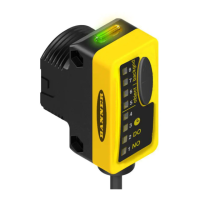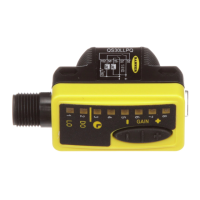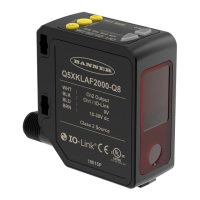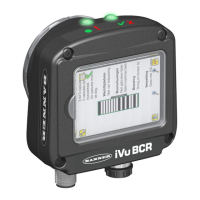Figure 2. Two-Point TEACH (Light Operate
shown)
Two-Point Static TEACH
• Two-point TEACH
• Sets a single switching threshold
• Threshold is adjustable using “+” and “-” buttons (Manual Adjust)
Two-Point Static TEACH is the traditional setup method, used when two conditions
can be presented by the user. The sensor locates a single sensing threshold (the
switch point) midway between the two taught conditions, with the Output ON
condition on one side, and the Output OFF condition on the other (see Figure 2).
The first condition taught is the ON condition.The Output ON and OFF conditions can
be reversed by changing Light/Dark Operate status in SETUP mode.
Two-Point TEACH and Manual Adjust
Using Manual Adjust with Two-Point TEACH moves the switching threshold. The
lighted LED on the light bar will move to exhibit the relative amount of received signal.
Push Button Remote Line Display Shows
• Press and Hold
No action required;
sensor is ready for
1st TEACH condition.
Power LED: OFF
Output LED: ON
Bargraph: #5 & 6 Flashing
Present Output ON
condition
• Click
• Present Output ON
condition
• Single-pulse remote
line
Power LED: OFF
Output LED: OFF
Bargraph: #5 & 6 Flashing
Access
TEACH Mode
Learn Output
ON Condition
Present Output
OFF condition
• Click
• Present Output OFF
condition
• Single-pulse remote
line
Teach Accepted
Power LED: ON
Bargraph: One LED flashes to show
relative contrast (good contrast
shown; see table above)
Sensor returns to RUN mode
Learn Output
OFF Condition
Teach Unacceptable
Power LED: OFF
Bargraph: #1, 3, 6, 8 flash to show fail
Sensor returns to “Learn Output ON”
condition
Bargraph
LED
Number
Relative Contrast/
Recommendation
6 to 8 Excellent: Very stable operation.
4 to 5
Good: Minor sensing variables will
not affect sensing reliability.
2 to 3
Low: Minor sensing variables will
affect sensing reliability.
1
Marginal: Consider an alternate
sensing scheme.

